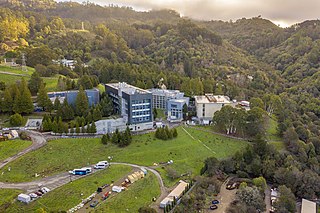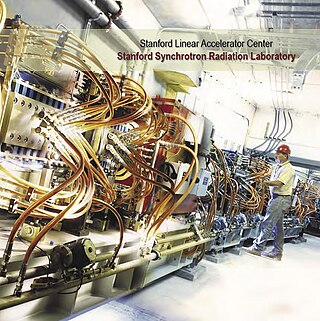Keith O. Hodgson (born 1947 in Virginia) is a professor of chemistry at Stanford University [1] and formerly director of the Stanford Synchrotron Radiation Lightsource. [2]
Keith O. Hodgson (born 1947 in Virginia) is a professor of chemistry at Stanford University [1] and formerly director of the Stanford Synchrotron Radiation Lightsource. [2]
He received his B.S. in 1969 from the University of Virginia and his Ph.D. in 1972 from University of California at Berkeley. [3]
He joined Stanford's chemistry department in 1973 and then he became a full-time chemistry professor in 1984. His principal research interests include inorganic, bioinorganic, structural and biophysical chemistry. His research group focuses on questions relating to how structure at different organizational levels relates to function. His research is done using a number of different x-ray spectroscopic and scattering techniques such as x-ray absorption spectroscopy (XAS).
One of his main area of focus is the active site of the enzyme nitrogenase, which is responsible for conversion of atmospheric dinitrogen to ammonia. Using XAS studies at the S, Fe and Mo edge, his group has worked to understand the electronic structure as a function of redox in this cluster. Other projects include the study of iron in dioxygen activation and oxidation and the role of copper in electron transport and in dioxygen activation.
Over his career he has earned the following awards: NATO Postdoctoral Fellow, E.T.H. (Zurich) 1972-73, Alfred P. Sloan Foundation Fellow, 1976–78; Sidhu Award for Contributions to X-ray Diffraction, 1978; World Bank Lecturer, 1984, and the Ernest Orlando Lawrence Award in 2002. [4]
Keith Hodgson was previously the Deputy Director of the Synchrotron Division of the Stanford Linear Accelerator Center and Professor of Chemistry and SSRL. Hodgson and his students began work at SSRL in 1974 where they quickly made important fundamental discoveries in the utilization of synchrotron x-rays for studies of chemical and biological structure. He became the Division Director on July 1, 1998.

DESY, short for Deutsches Elektronen-Synchrotron, is a national research centre for fundamental science located in Hamburg and Zeuthen near Berlin in Germany. It operates particle accelerators used to investigate the structure, dynamics and function of matter, and conducts a broad spectrum of interdisciplinary scientific research in four main areas: particle and high energy physics; photon science; astroparticle physics; and the development, construction and operation of particle accelerators. Its name refers to its first project, an electron synchrotron. DESY is publicly financed by the Federal Republic of Germany and the Federal States of Hamburg and Brandenburg and is a member of the Helmholtz Association of German Research Centres.

SLAC National Accelerator Laboratory, originally named the Stanford Linear Accelerator Center, is a federally funded research and development center in Menlo Park, California, United States. Founded in 1962, the laboratory is now sponsored by the United States Department of Energy and administrated by Stanford University. It is the site of the Stanford Linear Accelerator, a 3.2 kilometer (2-mile) linear accelerator constructed in 1966 that could accelerate electrons to energies of 50 GeV.

Lawrence Berkeley National Laboratory (LBNL) is a federally funded research and development center in the hills of Berkeley, California, United States. Established in 1931 by the University of California (UC), the laboratory is sponsored by the United States Department of Energy and administrated by the UC system. Ernest Lawrence, who won the Nobel prize for inventing the cyclotron, founded the Lab and served as its Director until his death in 1958. Located in the hills of Berkeley, California, the lab overlooks the campus of the University of California, Berkeley.

A synchrotron light source is a source of electromagnetic radiation (EM) usually produced by a storage ring, for scientific and technical purposes. First observed in synchrotrons, synchrotron light is now produced by storage rings and other specialized particle accelerators, typically accelerating electrons. Once the high-energy electron beam has been generated, it is directed into auxiliary components such as bending magnets and insertion devices in storage rings and free electron lasers. These supply the strong magnetic fields perpendicular to the beam that are needed to convert high energy electrons into photons.

Extended X-ray absorption fine structure (EXAFS), along with X-ray absorption near edge structure (XANES), is a subset of X-ray absorption spectroscopy (XAS). Like other absorption spectroscopies, XAS techniques follow Beer's law. The X-ray absorption coefficient of a material as a function of energy is obtained using X-rays of a narrow energy resolution are directed at a sample and the incident and transmitted x-ray intensity is recorded as the incident x-ray energy is incremented.

The Stanford Synchrotron Radiation Lightsource, a division of SLAC National Accelerator Laboratory, is operated by Stanford University for the Department of Energy. SSRL is a National User Facility which provides synchrotron radiation, a name given to electromagnetic radiation in the x-ray, ultraviolet, visible and infrared realms produced by electrons circulating in a storage ring at nearly the speed of light. The extremely bright light that is produced can be used to investigate various forms of matter ranging from objects of atomic and molecular size to man-made materials with unusual properties. The obtained information and knowledge is of great value to society, with impact in areas such as the environment, future technologies, health, biology, basic research, and education.

Electron scattering occurs when electrons are displaced from their original trajectory. This is due to the electrostatic forces within matter interaction or, if an external magnetic field is present, the electron may be deflected by the Lorentz force. This scattering typically happens with solids such as metals, semiconductors and insulators; and is a limiting factor in integrated circuits and transistors.
X-ray absorption near edge structure (XANES), also known as near edge X-ray absorption fine structure (NEXAFS), is a type of absorption spectroscopy that indicates the features in the X-ray absorption spectra (XAS) of condensed matter due to the photoabsorption cross section for electronic transitions from an atomic core level to final states in the energy region of 50–100 eV above the selected atomic core level ionization energy, where the wavelength of the photoelectron is larger than the interatomic distance between the absorbing atom and its first neighbour atoms.
Sebastian Doniach is a British-American physicist and professor at Stanford University. His research interests include theoretical condensed matter physics, superconductivity, and biophysics.
Joachim Stöhr is a physicist and professor emeritus of the Photon Science Department of Stanford University. His research has focused on the development of X-ray and synchrotron radiation techniques and their applications in different scientific fields with emphasis on surface science and magnetism. During his career he also held several scientific leadership positions, such as the director of the Stanford Synchrotron Radiation Laboratory (SSRL) and he was the founding director of the Linac Coherent Light Source (LCLS), the world's first x-ray free electron laser.

A particle accelerator is a machine that uses electromagnetic fields to propel charged particles to very high speeds and energies, and to contain them in well-defined beams.
The Canadian Synchrotron Radiation Facility (CSRF) was Canada's national synchrotron facility from 1983 to 2005. Eventually consisting of three beamlines at the Synchrotron Radiation Center at the University of Wisconsin–Madison, USA, it served the Canadian synchrotron community until the opening of the Canadian Light Source in Saskatoon, Saskatchewan, finally ceasing operations in 2008.

Herman Winick is an American scientist and Professor Emeritus at the Stanford Linear Accelerator Center (SLAC) and the Applied Physics Department of Stanford University.
James Penner-Hahn is the George A. Lindsay Collegiate Professor of Chemistry and Biophysics at the University of Michigan. He completed a Bachelor of Science degree with Honors at Purdue University in 1979 and a PhD at Stanford University in 1984 under Keith Hodgson; his dissertation was titled X-ray Absorption Studies of Metalloprotein Structure: Cytochrome P-450, Horseradish Peroxidase, Plastocyanin, and Laccase. Penner-Hahn's research involves biophysical chemistry and inorganic spectroscopy including EXAFS and synchrotron radiation techniques which he helped to develop in his doctoral and post-doctoral work with Edward Solomon and Hodgson. He was elected as a Fellow of the American Association for the Advancement of Science in 2004.
Zhi-Xun Shen is a Chinese-American experimental and solid state physicist who is a professor at Stanford University. He is particularly noted for his ARPES studies on high-temperature superconductors.
Evert Ingolf Lindau is a Swedish physicist and professor emeritus at Lund University and Stanford University and a member of the Royal Swedish Academy of Sciences.
Serena DeBeer is an American chemist. She is currently a W3-Professor and the director at the Max Planck Institute for Chemical Energy Conversion in Muelheim an der Ruhr, Germany, where she heads the Department of Inorganic Spectroscopy. Her expertise lies in the application and development of X-ray based spectroscopic methods as probes of electronic structure in biological and chemical catalysis.

SOLARIS is the only synchrotron in Central-Eastern Europe. Built in Poland in 2015, under the auspices of the Jagiellonian University, it is located on the Campus of the 600th Anniversary of the Jagiellonian University Revival, in the southern part of Krakow. It is the central facility of the National Synchrotron Radiation Centre SOLARIS.
The National User Facilities are a set of large-scale scientific facilities maintained by the U.S. Department of Energy, Office of Science, whose roles are to provide the scientific community with world-leading scientific instruments to enable research. These facilities are generally free to use, and are open to scientists from all over the world, usually through the submission and evaluation of research proposals.
Ingrid Jane Pickering is a geoscientist. She is a professor and Canada Research Chair in Molecular Environmental Science at the University of Saskatchewan. In 2018, Pickering was the first woman appointed Chair of the Canada Foundation for Innovation Board of Directors.